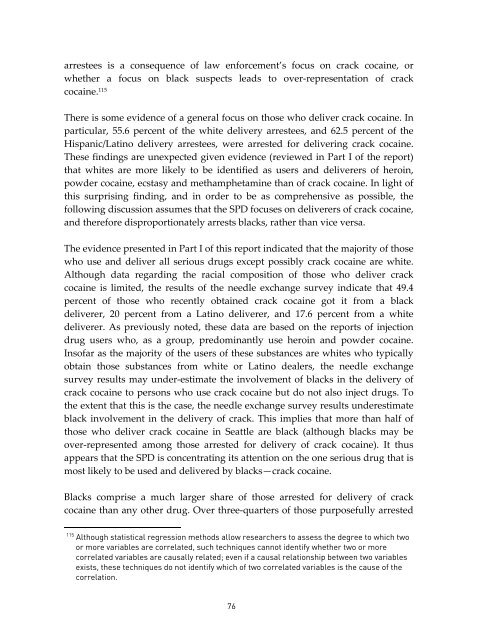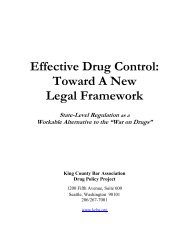RACE AND THE ENFORCEMENT OF DRUG DELIVERY LAWS IN ...
RACE AND THE ENFORCEMENT OF DRUG DELIVERY LAWS IN ...
RACE AND THE ENFORCEMENT OF DRUG DELIVERY LAWS IN ...
Create successful ePaper yourself
Turn your PDF publications into a flip-book with our unique Google optimized e-Paper software.
arrestees is a consequence of law enforcement’s focus on crack cocaine, or<br />
whether a focus on black suspects leads to over-representation of crack<br />
cocaine. 115<br />
There is some evidence of a general focus on those who deliver crack cocaine. In<br />
particular, 55.6 percent of the white delivery arrestees, and 62.5 percent of the<br />
Hispanic/Latino delivery arrestees, were arrested for delivering crack cocaine.<br />
These findings are unexpected given evidence (reviewed in Part I of the report)<br />
that whites are more likely to be identified as users and deliverers of heroin,<br />
powder cocaine, ecstasy and methamphetamine than of crack cocaine. In light of<br />
this surprising finding, and in order to be as comprehensive as possible, the<br />
following discussion assumes that the SPD focuses on deliverers of crack cocaine,<br />
and therefore disproportionately arrests blacks, rather than vice versa.<br />
The evidence presented in Part I of this report indicated that the majority of those<br />
who use and deliver all serious drugs except possibly crack cocaine are white.<br />
Although data regarding the racial composition of those who deliver crack<br />
cocaine is limited, the results of the needle exchange survey indicate that 49.4<br />
percent of those who recently obtained crack cocaine got it from a black<br />
deliverer, 20 percent from a Latino deliverer, and 17.6 percent from a white<br />
deliverer. As previously noted, these data are based on the reports of injection<br />
drug users who, as a group, predominantly use heroin and powder cocaine.<br />
Insofar as the majority of the users of these substances are whites who typically<br />
obtain those substances from white or Latino dealers, the needle exchange<br />
survey results may under-estimate the involvement of blacks in the delivery of<br />
crack cocaine to persons who use crack cocaine but do not also inject drugs. To<br />
the extent that this is the case, the needle exchange survey results underestimate<br />
black involvement in the delivery of crack. This implies that more than half of<br />
those who deliver crack cocaine in Seattle are black (although blacks may be<br />
over-represented among those arrested for delivery of crack cocaine). It thus<br />
appears that the SPD is concentrating its attention on the one serious drug that is<br />
most likely to be used and delivered by blacks—crack cocaine.<br />
Blacks comprise a much larger share of those arrested for delivery of crack<br />
cocaine than any other drug. Over three-quarters of those purposefully arrested<br />
115<br />
Although statistical regression methods allow researchers to assess the degree to which two<br />
or more variables are correlated, such techniques cannot identify whether two or more<br />
correlated variables are causally related; even if a causal relationship between two variables<br />
exists, these techniques do not identify which of two correlated variables is the cause of the<br />
correlation.<br />
76

















